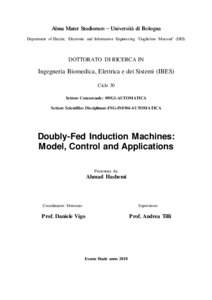Hashemi, Ahmad
(2018)
Doubly-Fed Induction Machines: Model, Control and Applications, [Dissertation thesis], Alma Mater Studiorum Università di Bologna.
Dottorato di ricerca in
Ingegneria biomedica, elettrica e dei sistemi, 30 Ciclo. DOI 10.6092/unibo/amsdottorato/8485.
Documenti full-text disponibili:
![Thesis-Hashemi.pdf [thumbnail of Thesis-Hashemi.pdf]](https://amsdottorato.unibo.it/8485/1.hassmallThumbnailVersion/Thesis-Hashemi.pdf)  Anteprima |
Documento PDF (English)
- Richiede un lettore di PDF come Xpdf o Adobe Acrobat Reader
Disponibile con Licenza: Salvo eventuali più ampie autorizzazioni dell'autore, la tesi può essere liberamente consultata e può essere effettuato il salvataggio e la stampa di una copia per fini strettamente personali di studio, di ricerca e di insegnamento, con espresso divieto di qualunque utilizzo direttamente o indirettamente commerciale. Ogni altro diritto sul materiale è riservato.
Download (2MB)
| Anteprima
|
Abstract
Renewable energy resources far outweigh fossil fuels in several terms of benefits, i.e. environmentally friendly, and economically.
Wind Energy Conversion Systems are the fastest grown units among renewables within recent years. Due to large penetration of wind units in nowadays power systems, some specific regulations have been issued through modern national grid codes to manage their technical commitments. Low Voltage Ride Through (LVRT), as one of the most important requirements, asks wind units to ride through some predefined grid low voltage conditions in terms of amplitude reduction and time duration, mainly caused by different types of balanced and/or unbalanced power network faults.
Doubly-Fed Induction Generators (DFIGs) as the most popular machines among the current driven wind turbines, are electrically connected to the grid through a three-phase winding placed at stator, while rotor is electromagnetically connected to stator. Hence, a sudden reduction of voltage profile, will trigger large current/flux oscillations in the machine, may hit the physical limits and consequently, violate grid codes.
The main topic of this thesis is modeling and control of DFIG-based wind turbine systems to substantiate LVRT requirements without imposing any additional hardware to installed components. To achieve this objective, system/control theory tools are applied to investigate the effects of grid faults on DFIG dynamics, and design proper control-based countermeasures. More specifically, taking advantage from analyzing the internal dynamics of DFIG, various feedforward-feedback controllers have been designed to deal with line faults having increasing complexity. A crucial role in such approach is played by a suitable state reference trajectory design, based on the feature of the DFIG internal dynamics.
Such kind of method has been applied to deal with the mechanical dynamics, as well. Numerical realistic simulations validate the benefits of the proposed controller, in crucially improving the machine response under severe grid faults.
Abstract
Renewable energy resources far outweigh fossil fuels in several terms of benefits, i.e. environmentally friendly, and economically.
Wind Energy Conversion Systems are the fastest grown units among renewables within recent years. Due to large penetration of wind units in nowadays power systems, some specific regulations have been issued through modern national grid codes to manage their technical commitments. Low Voltage Ride Through (LVRT), as one of the most important requirements, asks wind units to ride through some predefined grid low voltage conditions in terms of amplitude reduction and time duration, mainly caused by different types of balanced and/or unbalanced power network faults.
Doubly-Fed Induction Generators (DFIGs) as the most popular machines among the current driven wind turbines, are electrically connected to the grid through a three-phase winding placed at stator, while rotor is electromagnetically connected to stator. Hence, a sudden reduction of voltage profile, will trigger large current/flux oscillations in the machine, may hit the physical limits and consequently, violate grid codes.
The main topic of this thesis is modeling and control of DFIG-based wind turbine systems to substantiate LVRT requirements without imposing any additional hardware to installed components. To achieve this objective, system/control theory tools are applied to investigate the effects of grid faults on DFIG dynamics, and design proper control-based countermeasures. More specifically, taking advantage from analyzing the internal dynamics of DFIG, various feedforward-feedback controllers have been designed to deal with line faults having increasing complexity. A crucial role in such approach is played by a suitable state reference trajectory design, based on the feature of the DFIG internal dynamics.
Such kind of method has been applied to deal with the mechanical dynamics, as well. Numerical realistic simulations validate the benefits of the proposed controller, in crucially improving the machine response under severe grid faults.
Tipologia del documento
Tesi di dottorato
Autore
Hashemi, Ahmad
Supervisore
Dottorato di ricerca
Ciclo
30
Coordinatore
Settore disciplinare
Settore concorsuale
Parole chiave
Doubly-fed induction generator (DFIG); Wind turbine (WT); Feedforward-feedback control; Mapping solution; Low
voltage ride through (LVRT)
URN:NBN
DOI
10.6092/unibo/amsdottorato/8485
Data di discussione
8 Maggio 2018
URI
Altri metadati
Tipologia del documento
Tesi di dottorato
Autore
Hashemi, Ahmad
Supervisore
Dottorato di ricerca
Ciclo
30
Coordinatore
Settore disciplinare
Settore concorsuale
Parole chiave
Doubly-fed induction generator (DFIG); Wind turbine (WT); Feedforward-feedback control; Mapping solution; Low
voltage ride through (LVRT)
URN:NBN
DOI
10.6092/unibo/amsdottorato/8485
Data di discussione
8 Maggio 2018
URI
Statistica sui download
Gestione del documento:


 Login
Login
